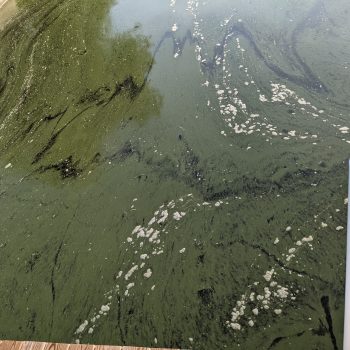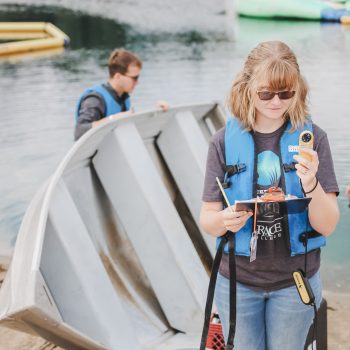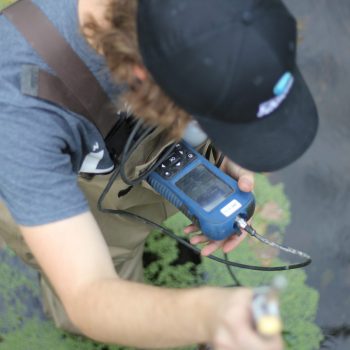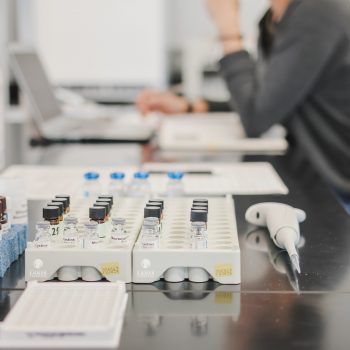Blue-Green Algae Expert Guide
You think you have a blue-green algae bloom. Now what?
We call them algae, but in reality, blue-green algae are a type of bacteria. Here's how you can identify the species and help prevent future blooms.
Blue-green algae blooms and the toxin they produce, microcystin, are known for making people (and particularly pets) sick. In Kosciusko County, Ind., blooms typically happen in mid-to-late summer. Warm weather and plenty of sunshine, as well as increased nutrients, are the key factors.
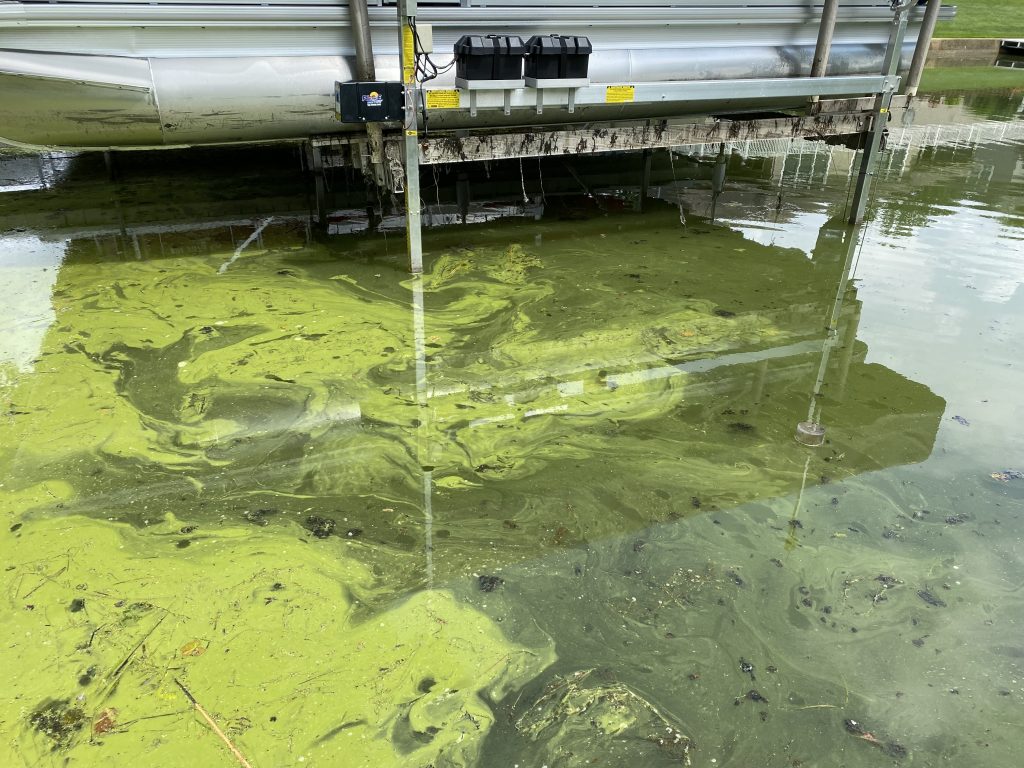
What does blue-green algae look like?
During its peak, a blue-green bloom will look like paint or pea soup. It may even filter down into the water column, rather than stay on the surface. Sometimes cells can clump together, but they will not be picked up easily.
Blue-green algae are not true algae. That is why cells interact with water differently than true algae, almost appearing to be a part of a water.
We call them algae because they are free-floating and grow in aquatic colonies, but in reality, blue-green algae are a type of bacteria. That means you will not be able to identify individual cells or roots, like you can with aquatic plants.
This video, taken by an observant Big Chapman resident, shows how blue-green algae moves. It stirs easily!
A blue-green algae bloom can change depending on the time of year and at different points in its lifecycle. For example, the picture on the left shows what a dying bloom looks like: less vibrant, more muted, still paint-like.
Occasionally, we see blooms during winter. Center Lake (the picture on the right) experienced a “red” toxic algae bloom in early 2021! Blue-green algae prefer warm weather and still, stagnant, nutrient-rich water ― but they can bloom unpredictably.
Does it always produce microcystin?
Blue-green algae are full of mysteries … and one of those is that a bloom will not always produce microcystin! It always has the potential to, though, and that is why the Lilly Center recommends staying away from water that has a visible bloom. There is no way to tell if the bloom is toxic until the water is tested.
Blue-green algae is a nickname for aquatic cyanobacteria, such as Microcystis, Anabaena, and Cylindrospermopsis. The Lilly Center currently focuses on the microcystin toxin, which can be produced by both Microcystis and Anabaena, among others. We sample 14 local lakes and seven public beaches and gather water samples for testing in our own lab, including counting and identifying algae species.
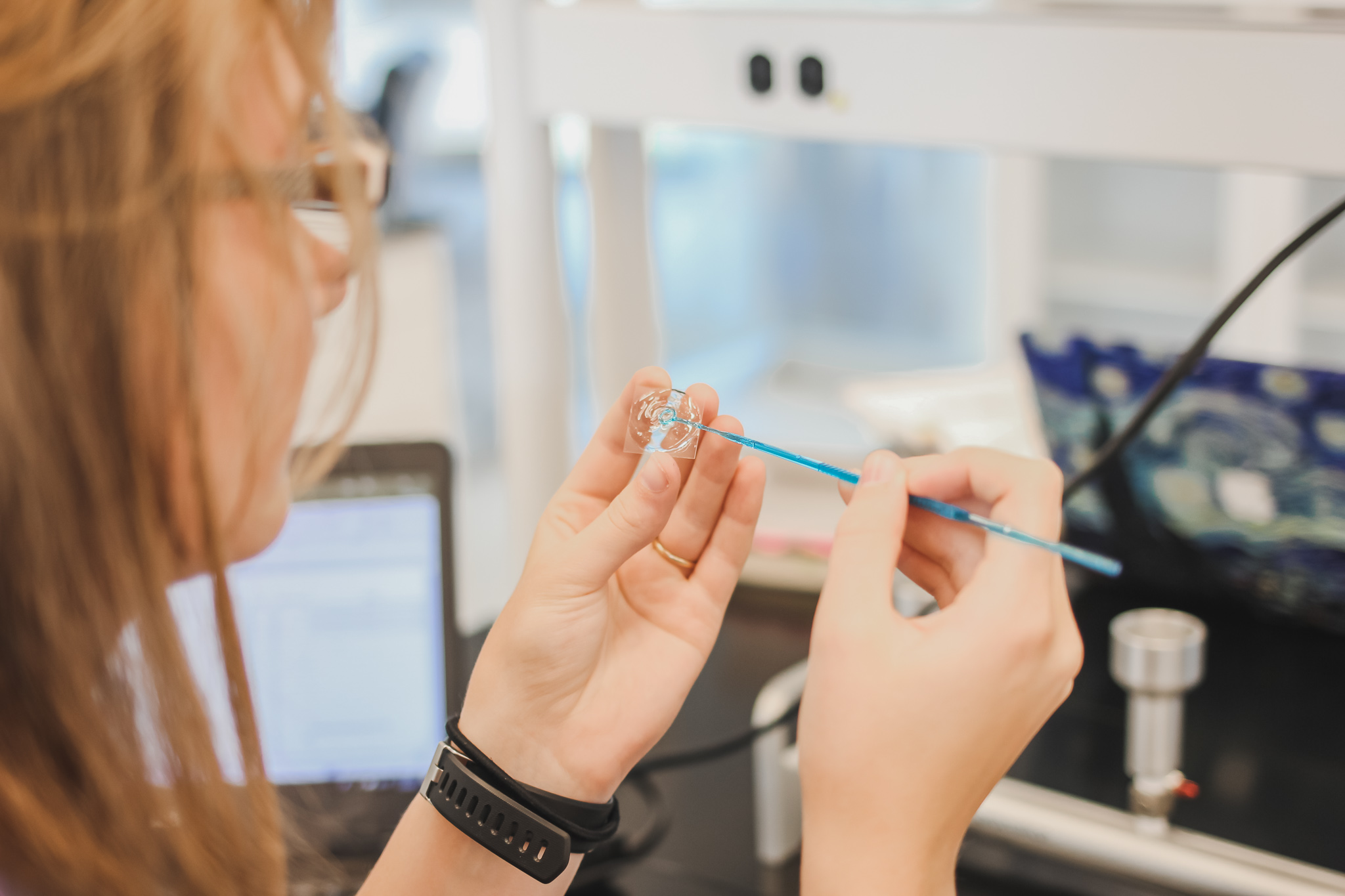
Microcystin toxin in local lakes
You can view weekly microcystin data on this page during our summer sampling season, from June-August.
What will happen if I come into contact with blue-green algae?
Depending on how much microcystin-laden water is ingested, the toxin can cause anything from mild stomach irritation to vomiting, diarrhea, rashes, eye irritation, coughing, sore throats and headaches.
If you come into contact with a blue-green algae bloom, wash well with warm, soapy water. Pets that have made contact with a bloom should be washed off with fresh water as soon as possible.
In general, avoid coming into contact with the bloom itself: the scummy, blue-green part. You can still enjoy the water in other ways, like boating and fishing. Activities that bring you into direct contact with the water put you at a higher risk. Never drink the water!
What causes blue-green algae blooms?
Blooms typically occur in late summer, when the water and weather are warm and extra nutrients enter the lake.
Nutrients come from a variety of sources, including storm water runoff, nearby facilities and agriculture, and even your own property. Here are two ways you can help:
- Fertilize carefully. Excess fertilizer from your lawn will wash into the lakes and lead to more algae and weeds.
- Properly dispose of yard clippings. Never blow them into the lake or street.
The top two nutrients to watch out for are phosphorus and nitrogen.
When these two are introduced into lakes in large amounts, blue-green algae (and other species of algae and weeds) can become out of balance with other plants and animals. They spread quickly and smother other kinds of aquatic plants. Then, the algae grows and multiplies until it uses up available resources.
When the bloom begins to die, it releases a toxin (microcystin) if the cells contain it.

Blue-green algae vs. green algae
The green stuff you see in your lake might not be blue-green algae. Here are a few identifiers:
- If you see leaves or roots, or distinguishable parts, it is likely a tiny (and harmless) aquatic plant like duckweed.
- Stringy, silky substances that can be draped over a stick are green algae.
- If it is yellow and almost “dusty” in texture, it might act like blue-green algae, but it is actually tree pollen.
Here is some good news: Not every bloom is a toxic blue-green one!
While blue-green algae are actually bacteria, green algae are in Kingdom Plantae along with the terrestrial plants we see every day. Like grass in a pasture, filamentous green algaes are primary producers within aquatic ecosystems; they root onto submerged rocks and hard surfaces, photosynthesize to grow, and become food for grazers like crayfish, zooplankton and insects, snails, and small fish. Even ducks will dive underwater to snack on these greens.
With abundant nutrients and sunlight, the green algae can grow faster than those primary producers can eat it.
In this case, algae-covered rocks and structures can start to look like they have grown a head of wispy, verdant hair. Each one of these hairs is called a “filament.” With even more photosynthesis, and these hairs can trap bubbles of oxygen they produce and begin to float upward. When they finally detach from their growing spot, filamentous green algae colonies create tangled, bubbly clumps on the surface of your lake or pond. You can observe their filamentous nature for yourself by submerging a stick, kayak paddle, or even your hand into the mat. Lifting a piece of the mat will make the algae drape like hair.
Their hair-like structure is key to distinguishing green algae blooms from potentially toxic blue-green ones.
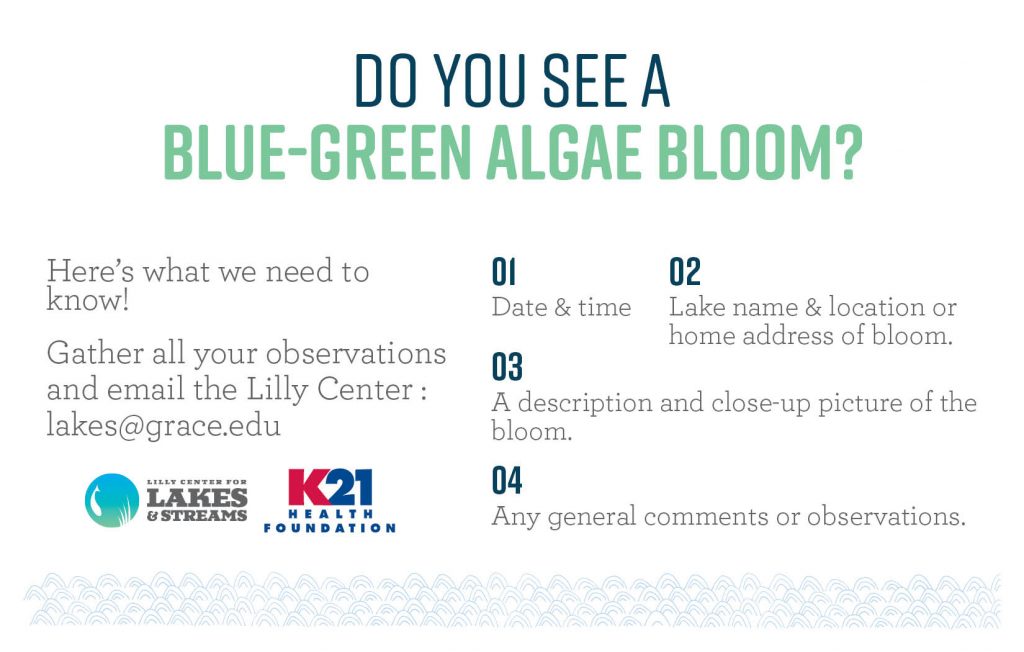
What should I do if I see a bloom?
Try the “stick test.”
Dip a stick into the bloom. If the algae hangs off the stick in long, hair-like strands, it is likely some species of green algae. It is non-toxic, and although yucky to look at, it will not harm you or your pets.
If the algae does not drape off the stick and is easily stirred, it may be blue-green algae. Keep pets and people away from the bloom for awhile. Consider some other kind of activity for that day! With enough time and sunlight, the bloom will die away.
If you live in Kosciusko County, reach out to us.
Take a picture of the bloom, note the date, time and location, and send us an email with what you find: lakes@grace.edu. Please note: right now, we only conduct research on lakes within Kosciusko County.
Be patient.
Blooms die when exposed to sunlight. Scientists do not know how long it takes toxins to dissipate; it could be anywhere from a single day to several weeks. You will know the water is safe to enjoy when there is no visible bloom and the water looks clear or “normal.”
How do I prevent blooms?
There are a few ways to help limit blooms. This is what the Indiana Department of Natural Resources (IDEM) suggests:
- Most established lawns do NOT need phosphorus to be healthy. If applying fertilizer, use a phosphorus-free lawn fertilizer. This is critical if you live on a lake. Lawn-fertilizer packaging is labeled with three numbers for nutrient content. A zero as the middle number indicates a phosphorus-free fertilizer.
- Do not over fertilize in your garden. Check soil nutrient levels prior to applying garden fertilizer to ensure correct application. Soil test kits can be purchased from some local hardware stores and through online distributors.
- Do not fertilize up to the edge of a waterway. Check with your local government for any specific setback requirements.
- Do not dispose of grass clippings or leaves in or near a waterway.
- To prevent inputs from human waste, have your septic system inspected and tank pumped out at least every two years.
- If conducting land disturbing activity, prevent soil and organic matter from washing into waterways, as soil can carry nutrients into the waterway.
How the Lilly Center monitors blue-green algae
Microcystin is the most common toxin produced by cyanobacteria in our county, so that is what the Lilly Center focuses on. We measure microcystin in parts per billion (ppb). Think about it this way: For every drop of toxin, there would be a billion drops of water. That tells you how potent the toxin is!
Every week during the summer, supported by the K21 Health Foundation, the Lilly Center tests and reports microcystin concentrations of water samples from 14 all-sport lakes and seven public swimming beaches. That information is posted to our microcystin data page.
We follow IDEM’s standards: Animals are at risk at concentrations 0.8 ppb or above. Humans are less sensitive to the toxin than animals; humans are advised to stay out of the water at concentrations of 8.0 ppb or above.
Algae populations and toxin conditions vary between lakes, which is why not all lakes can be treated the same. Due to previous research, forecasting and prediction are not currently accurate, feasible ways of determining whether water is safe. That is why the Lilly Center looks at other factors, too, to see if any of those point to why and when blue-green algae produces toxins.
The Research
The Lilly Center was founded on blue-green algae research. That is our primary focus while we conduct lake sampling every summer, and stream sampling year-round.
The Resources
We do not conduct cyanobacteria research alone! We rely on the insight of other trustworthy organizations. Click through to learn more about blue-green algae from each of these sources.
Blue-Green Algae Webinar
Prefer to watch, rather than read? This Lilly Center webinar will teach you everything you need to know about blue-green algae.
